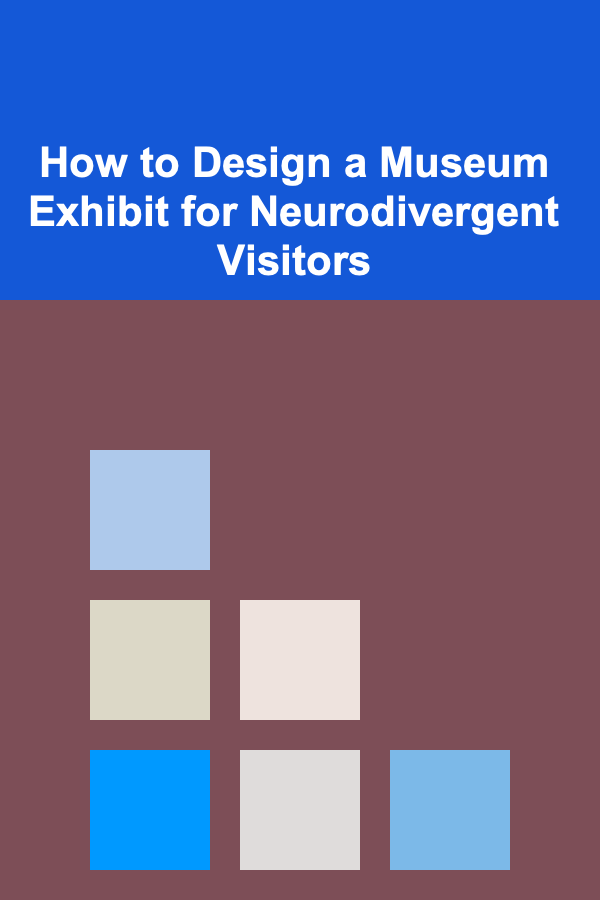
How to Design a Museum Exhibit for Neurodivergent Visitors
ebook include PDF & Audio bundle (Micro Guide)
$12.99$5.99
Limited Time Offer! Order within the next:

Museums serve as spaces of education, culture, and exploration, offering visitors a chance to engage with art, history, science, and more. However, when designing museum exhibits, it is crucial to consider the diversity of the audience, particularly neurodivergent individuals. Neurodiversity encompasses a range of neurological variations, including autism, ADHD, dyslexia, and other conditions, each of which might influence how individuals interact with their environment and consume information.
Designing exhibits with neurodivergent visitors in mind goes beyond ensuring accessibility; it involves creating an inclusive environment where everyone, regardless of their neurological makeup, can engage, learn, and enjoy their experience. This article will explore how to design museum exhibits that are welcoming and enriching for neurodivergent visitors, offering practical advice and strategies based on the principles of inclusivity and universal design.
Understanding Neurodivergence and Its Impact on Museum Experiences
Neurodivergence refers to a variety of neurological differences that can affect how individuals think, learn, and interact with the world around them. Conditions such as autism spectrum disorder (ASD), attention-deficit/hyperactivity disorder (ADHD), dyslexia, and others can influence sensory processing, social interaction, and cognitive function. Understanding these differences is the first step toward designing a museum experience that is inclusive.
Common Traits of Neurodivergent Visitors
While each neurodivergent individual is unique, there are several traits commonly observed across different conditions:
- Sensory Sensitivities: Many neurodivergent individuals are more sensitive to sensory stimuli like bright lights, loud sounds, and strong smells. This sensitivity can be overwhelming in a museum setting, especially with exhibits that are noisy, brightly lit, or feature complex visual displays.
- Difficulty with Focus and Attention: Visitors with ADHD may struggle with long, dense information displays or distractions in a busy environment, making it harder for them to focus on exhibits.
- Preference for Structure and Predictability: Neurodivergent visitors may benefit from clear, predictable routines and instructions. They may find it challenging to navigate spaces without explicit directions or easily accessible information.
- Need for Quiet and Calming Spaces: For individuals with ASD, particularly those who are hypersensitive to stimuli, noisy and chaotic environments may lead to anxiety or sensory overload. Quiet, calming spaces are crucial to allow them to process information and recharge.
- Diverse Learning Styles: Neurodivergent individuals may learn and process information differently, with some benefiting from visual aids, others from interactive experiences, and still others from auditory components.
By considering these traits, museums can design exhibits that cater to the needs of neurodivergent visitors, helping them feel more comfortable, engaged, and informed.
Key Principles of Neurodivergent-Friendly Museum Design
Designing a museum exhibit for neurodivergent visitors involves more than simply adding accessibility features. The design should be intentional, considering the various sensory, cognitive, and social needs of neurodivergent individuals. Below are key principles to keep in mind.
1. Sensory Considerations: Balance Stimulation
One of the most important aspects of designing a neurodivergent-friendly museum is managing sensory stimuli. Museums can be overwhelming with their bright lights, loud sounds, and busy environments. A sensory-friendly design ensures that the museum remains engaging without overwhelming visitors.
Lighting
- Use soft, adjustable lighting to create a calming environment. Avoid harsh fluorescent lighting that may trigger discomfort or sensory overload.
- Allow visitors to adjust the lighting in specific areas or use natural light where possible.
Sound
- Reduce ambient noise and provide quiet spaces where visitors can retreat if they feel overwhelmed.
- Incorporate soundproofing in areas where noise levels are higher or where interactive elements may make loud noises.
- Offer headphone jacks or personal volume controls for exhibits that involve sound. Provide quiet zones for those who need to escape noise.
Textures and Materials
- Offer tactile experiences that are calming, such as soft surfaces, plush materials, or natural textures. Be mindful that certain textures might be uncomfortable for some individuals, so a variety of options is important.
- Use non-glossy, matte finishes for signage or displays to minimize visual distractions.
Space Design
- Keep spaces open and uncluttered to avoid a feeling of confinement or sensory overload.
- Create designated areas where visitors can sit, rest, or take a break from the exhibit. These spaces should be quiet, with low lighting and minimal visual stimuli.
2. Clear Signage and Instructions
Neurodivergent individuals, particularly those with ASD or ADHD, may struggle with navigating spaces that lack clear, consistent, and simple instructions. Signage and instructions should be explicit, easy to read, and predictable.
Consistent Signage
- Use large, clear fonts and high-contrast colors for easy readability. Consider using icons or images to enhance understanding.
- Provide step-by-step instructions or guidance for navigating the exhibit, especially in interactive or immersive areas. This helps visitors know what to expect and reduces anxiety about the unknown.
Visual Cues
- Provide visual markers such as arrows or colored pathways to guide visitors through the exhibit. This helps neurodivergent visitors follow the flow of the exhibit without feeling lost or confused.
- Offer diagrams, maps, or apps that visitors can refer to for additional guidance.
Simple and Direct Language
- Use clear, straightforward language in all written materials. Avoid overly complex or abstract language that could cause confusion.
- Offer both text and audio versions of exhibit labels, descriptions, and instructions to accommodate different learning styles.
3. Interactive and Engaging Experiences
Interactive exhibits can be particularly beneficial for neurodivergent visitors, as they provide a hands-on approach to learning that accommodates a range of learning styles. However, these experiences must be designed with inclusivity in mind.
Visual and Tactile Interactions
- Include touchable displays, such as models of artifacts or objects, that allow visitors to engage with the content in a tactile way. This can be particularly appealing to individuals with ASD, who may benefit from sensory exploration.
- For those with visual impairments or difficulty with reading, consider creating exhibits with braille or audio guides that provide descriptive information about the objects or artworks.
Digital and Virtual Engagement
- Digital tools, such as touchscreen kiosks, virtual reality (VR), or augmented reality (AR), can offer immersive, interactive experiences. However, it is important to ensure that these technologies are user-friendly and do not overwhelm visitors with complicated interfaces or excessive stimuli.
- Allow visitors to control the pace of their interaction, so they can explore at their own speed without feeling pressured or hurried.
Quiet and Calming Activities
- Provide interactive elements that allow visitors to engage with the exhibit in a quieter, more contemplative way, such as art creation stations, coloring sheets, or calm storytelling experiences.
- Design multi-sensory experiences that allow visitors to explore a topic through different modalities (sight, sound, touch, and even smell) to cater to different sensory preferences.
4. Providing Quiet Zones
Quiet zones are essential for neurodivergent visitors who may experience sensory overload in busier areas of the museum. These spaces offer a reprieve from the stimuli and allow individuals to process information and recharge.
Features of Quiet Zones
- Soft seating, such as cushions or bean bags, where visitors can rest and take a break.
- Minimal stimuli, with calming lighting, soft music, and neutral colors.
- A clear indication of when visitors are entering a quiet space, helping them recognize that it is a designated retreat area.
5. Staff Training and Visitor Support
Even the most thoughtfully designed exhibit can fall short without staff who are trained to understand and support neurodivergent visitors. Staff should be prepared to assist visitors with navigating the space, offer guidance when needed, and provide help if any difficulties arise.
Staff Training
- Train staff to recognize and respond to the needs of neurodivergent visitors, including how to provide support in a respectful and non-intrusive manner.
- Educate staff about different neurodivergent conditions and the challenges visitors might face, ensuring they can offer empathetic and patient assistance.
Providing Support
- Designate staff members as "helpers" in high-traffic areas or at particularly engaging exhibits to provide support and guidance to those who need it.
- Create a visitor support system, such as a hotline or assistance kiosk, where neurodivergent visitors can easily request help or get information about the museum's sensory features.
Collaborating with Neurodivergent Individuals
One of the best ways to design an exhibit that truly meets the needs of neurodivergent visitors is to involve them in the design process. Engaging neurodivergent individuals---whether they are experts, advocates, or visitors themselves---provides invaluable insights into the challenges they face and the features they would find beneficial.
How to Involve Neurodivergent Individuals
- Conduct focus groups or surveys with neurodivergent individuals to gather feedback on exhibit design, sensory features, and accessibility.
- Collaborate with advocacy groups that specialize in neurodivergence to get expert opinions on inclusive design principles.
- Test exhibits with neurodivergent visitors before they open to ensure that they meet their needs and expectations.
Conclusion
Designing a museum exhibit that is inclusive of neurodivergent visitors requires thoughtful planning, consideration of sensory experiences, and a commitment to accessibility. By following the principles of neurodivergent-friendly design---such as managing sensory stimuli, providing clear signage, creating interactive and engaging experiences, offering quiet zones, and training staff---museums can create environments that are welcoming to all visitors, regardless of their neurological makeup. Ultimately, the goal is to ensure that everyone has the opportunity to experience the joy and wonder that museums have to offer, while feeling comfortable and respected in the process.
Reading More From Our Other Websites
- [Gardening 101] The Best Garden Decor Ideas for Every Style and Budget
- [Weaving Tip 101] From Yarn to Fabric: Step-by-Step Techniques for Perfect Tension on a Rigid Heddle Loom
- [Home Budget 101] How to Track Home Expenses Effectively and Stay Within Budget
- [Personal Finance Management 101] How to Manage Your Finances as a Freelancer or Entrepreneur
- [Personal Investment 101] How to Build a Diversified Portfolio: Balancing Risk and Reward
- [Polymer Clay Modeling Tip 101] Common Conditioning Mistakes and How to Fix Them for Perfect Results
- [Home Security 101] How to Avoid Common Home Security Mistakes
- [Home Family Activity 101] How to Create a Cozy Family Reading Corner at Home
- [Home Holiday Decoration 101] How to Add a Bohemian Vibe to Your Holiday Decorations
- [Organization Tip 101] How to Monitor and Update Your Home Inventory Regularly

Affordable Holiday Planning: How to Save Money on Your Next Getaway
Read More
How to Build a Membership Recruitment Checklist for Your Environmental Organization: A Detailed Actionable Guide
Read More
How to Transform Your Bedroom into a Winter Wonderland for the Holidays
Read More
How to Turn Unused Spaces Into Valuable Storage Areas
Read More
Choosing the Right Hair Mask for Your Needs: A Comprehensive Guide
Read More
10 Tips for Building a Grocery List Generator That Actually Saves You Money
Read MoreOther Products

Affordable Holiday Planning: How to Save Money on Your Next Getaway
Read More
How to Build a Membership Recruitment Checklist for Your Environmental Organization: A Detailed Actionable Guide
Read More
How to Transform Your Bedroom into a Winter Wonderland for the Holidays
Read More
How to Turn Unused Spaces Into Valuable Storage Areas
Read More
Choosing the Right Hair Mask for Your Needs: A Comprehensive Guide
Read More